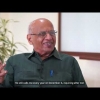Islamic mysticism is devoted to the promotion of onenness and pluralism.
The term SUFISM (tasawwuf) refers to the spiritual dimension and inner core of the world religion of Islam founded by the Prophet Muhammad. The tradition practiced by Islamic mystics is a religious current of devotion to the message of salvation embedded in the Qur'an and of rapture by the Divine which developed from the eighth and ninth centuries onwards. The texts of the mystic teachers contain a prescriptive utilization of the term Sufi which implies an ideal of ethical and spiritual perfection. The ethical values to which Sufis feel bound and which characterize their traditions include insights and modes of behaviour which in western overviews are categorized as expression of liberalness, desire for freedom and ‘tolerance’. In this sense a Sufi can be called a Muslim humanist. While this designation is not incorrect, it is not entirely correct either: the spectrum of Sufism is so complex that reductions of this type seldom do justice to the subject. Against this background, I will first try to explain Muslim ideas which resemble western ideas of tolerance and then to point out relevant statements in the writings of the Sufis as sources of a factual non-interference in the religious acts of those of other faiths. In their everyday religious practice, Muslims often draw on poetry which belongs to this refined philosophical and literary form of Sufism. Second, in the context of Sufi rites, pilgrimages and ‘syncretic’ cults, I will discuss the co-existence of various groups and their traditions in sacred places — predominantly at the shrines of Muslim saints.
Ethical Terms and Ideas of the Sufi Tradition
In Muslim cultures, there are some terms used by mystics, theologians and thinkers both in texts and in everyday communication which in the broadest sense circumscribe non-interference and the acceptance of differences as well as acceptance of plurality. The Arabic word tasamuh means roughly forbearance and indulgence; this corresponds to the Turkish word musamaha, for which the Sufi poet Yunus Emre (d. 1321) also used the expression hos goermek (‘accept everything’). In Persian, alongside tasamuh the less positive term (‘to resign oneself’, ‘to put up with’) is used. In religious contexts, in the Sufi tradition of South Asia and also Afghanistan, scholars favour the North Indian term rawadari (derived from Persian rawa — ‘permitted’, ‘tolerated’); for ‘letting things happen’; in this sense Pakistani and Indian Sufis often use the expression: apna ‘aqida chodo nahin, dusre ka chedo nahin — ‘Keep your faith and do not interfere with those of others’. This wise saying in Urdu is based on the Qur’anic verse ‘To you your religion and to me mine’ (109:6) and arose in the nineteenth century in India in the course of the controversy between the Barelvi and the Deobandi movements. Some Sufis practice rawadari and non- interference only during prayers in a mosque or devotion at a saint’s shrine, after which time religious differences again take effect. Other followers of the ‘religion of love’ (as Sufism is often called) refrain from emphasizing Islam’s claim to superiority and accept the religiosity of non-Muslims and even respectfully recognize that all religions teach good things. In this latter, positively interpreted sense of rawadari Sufis in South Asia have for centuries propagated the old folk wisdom muhabbat sab ke liye, nafrat kisi se nahin — ‘Love for all, hate for no one’ — a saying which is written for example even on Pakistani trucks. It reflects the Sufi understanding of basic equality of all aulad-e Adam (‘descendants of Adam’).
Bridges to Tolerance: Mystical Thoughts and Values in Sufi Poetry
Sufi poetry contains many such distinct affirmations of God and human love which at the same time are the humanist foundation for the acceptance of diversity. The Andalusian Muhyi’ud-Din Ibn ‘Arabi (116 5-1240) who was so path breaking for the development of the Sufi tradition sees it as comprehensive hub al-hub, as ‘Love of love’ (Chebel 2010 p21). The love poet Fakhr ud-Din ‘Iraqi (d. 1289) was also inspired by his mystic philosophy and in his Lama’at (‘Highlights’) wrote: ‘Love is exalted above human thought, above the qualities of separation and unity’ (Schimmel 1982, p158). For him and for other Sufis ‘Love is all that exists in the world.’ (Schimmel 1985, p498). The ‘Friends of God’ (auliya Allah) and ‘People of the Heart’ (ahl-e dil), who have shaped mystic Islam with their teachings and their exemplary conduct, have time and again emphasized the concept of love — particularly also ‘empathetic love’ (rahmah). Basic values and truths derived from love, such as harmony, the good will and a relaxed from staying side by side or together, set an example which to this day mark the ‘religious climate’ both in the convents of the Sufi orders and at the saints’ shrines It is to the Sufi saint Bayezid Bastami (d. 874) who defined early Persian mysticism so remarkably that we owe the outstanding maxim: ‘He who grants the greatest leeway is the one who is closest to Allah’ (Holbein 2009, p273).
Ibn ‘Arabi was someone who depicted love of God in vivid images of earthly longing for love. His central teachings were conceptualized by commentators as wahdat al-wujud — ‘Unity of being’ ; in this theosophical system God appears as the origin of creation manifesting even in the smallest things in the world, as a divine breath permeates all things. This monistic idea of unity of Ibn ‘Arabi was later, especially in the eastem lands of Islam, summarized in the formulaic Persian expression hama ast — ‘All is He’ — which has come to define popular devotional Sufi Islam in South Asia. Some verses from his ‘The Interpreter of Desires’ (Tarjuman al-ashwaq/poem 11) have repeatedly been quoted since then by advocates of religious tolerance:
My heart has become capable of every form:
it is a pasture for gazelles and a convent for Christian monks,
and a temple for idols and the pilgrim's Kaa'ba,
and the tables of the Torah and the book of the Quran.
I follow the religion of Love: whatever way Love's camels take,
that is my religion and my faith.
As Annemarie Schimmel notes, ‘this seemingly so tolerant remark contains an observation about the author’s high spiritual rank: For him, the form of God is no longer the form of this or that religion excluding all others. But rather his own eternal form which he encounters at the end of his tawaf. Thus it is the great self-praise, recognition of an epiphany far beyond the “epiphany by the name”, but not tolerance as it is preached to the masses’ (Schimrnel
I985: 384). The experience of absolute unity and the uniqueness of God (tawhid) which all Islamic mystics speak of led Ibn ‘Arabi to be able to recognize the divine presence pantheistically in all things and beings created This recognition of diversity is also reflected in the 99 ‘Most Beautiful Names of God’, as well as in the works of Ibn ‘Arabi’s successor ‘Abdul Karim Jili (d. between. I408 and 1417), who in his al-insan al-kamil, ‘The Perfect Man’, names a wide variety of religious communities and then confesses in the context of interpreting certain verses of the Qur’an (5:48, 10:99): ‘Each of these sects reveres God, and God wishes to be revered’ (Jili 1981, p122). This shows that in the theosophical system of Ibn Arabi the empirical reality of religious diversity ultimately corresponds to the will of God and all people practice religion in a Way intended by Him. When it is stated in the Qur’an ‘There is no compulsion in faith’ (22256), this means that non-Islamic religions should therefore be tolerated and respected because they carry in them part of universal truth. And to this day the verses of Ibn ‘Arabi are understood as willingness of Sufis to enter into an inter-religious dialogue. However, it must be noted that representatives of a sober, ‘scriptural’ Sufism for the most part do not share these views, warn against mixing religious contents and draw clear distinctions vis-as/is other groups within Islam.
However, Ibn ‘Arabi distinctly warned against religious exclusiveness. In this vein, he wrote:
Do not attach yourself to any particular creed so exclusively that you disbelieve all the rest; otherwise you will lose much good, nay, you will fail to recognize the real truth of the matter. God, the omnipresent and omnipotent, is not limited by any one creed, for he says, ‘Wheresoever ye turn, there is the face of Allah.’ Everyone praises What he believes; his god is his own creature, and in praising it he praises himself. Consequently he blames the beliefs of others, which he would not do if he were just, but his dislike is based on ignorance (Armstrong 2.011 P141143).
Ibn ‘Arabi’s contemporary Baba Farid ud-Din Shakar-ganj (I173-I265) lived further in the eastern part of the Muslim world on the Indian subcontinent where many mystics are known for their enthusiastic stance of ardent love of God. Tradition has it that he addressed the following remarkable words to a visitor:
Don’t give me scissors! Give me a needle!
I sew together! I don’t cut apart! (Nizami I976, p 89)
Baba Farid’s dervish convent in Pakpattan located in what is today Pakistan became a place where Muslims and Hindus met and exchanged views peacefully, where saints even discussed questions of spirituality with Hindu yogis. And in this the conversion of Hindus was not Baba Far-id's immediate purpose.
The following quatrain is attributed to the arguably greatest and best-known Sufi master and poet, Jalal ud-Din Rumi (1207-1273) who came from Persia but lived most of his life in Anatolia:
Come! Come! It doesn’t matter what you are,
A kafir, an idol- or a fire-worshipper.
Come! Our caravan is not a place of despair!
Come! Even if you have broken your vows a hundred times, come yet again!
Come! (Halman and Metin, I983, p174-75)
Understood as a promise and invitation to brotherliness to everyone who visited his convent and shrine in Konya, these verses today seem virtually omnipresent on the Internet, whether as a motto of the Naqshbandi-Haqqani Sufi order or of the Christian Unitarian Church.
Other verses by Rumi show clearly that for him as for other Sufis who — to remain in their imagery — have drunk from the wine cup of ma’rifat (gnosticism) and haqiqat (mystic truth), religious differences among seekers of God are no longer relevant and are transcended. This means that in the pure experience of divine unity there is no more room for religious distinctions. The following two verses are also to be understood in this manner:
For those who love, there are no Muslims, Christians or Jews
(Rumi, 2oo5, p 75)
Hindus, Kipchaks, Anatolians, Ethiopians — they all lie peacefully in
their graves,
separately, yet of the same colour
(Halman and Metin, I983, p46).
Or this quatrain:
On the path of thirst the fool and the wise man are one.
In the ecstasy of love, uncles and strangers are one.
Let them sip the wine of unity:
And already the house of God and the temple of idols are one
(Holbein 2009, p203).
Sultan Bahu (I631-1691), the first important Sufi poet of rural Punjab in what is today Pakistan was, like many mystics, disappointed by the formalistic religiosity of normative Islam based on following laws and regulations; imbued with the absolute love of God, he very clearly expressed his dislike of institutionalized scriptural religion in the first two lines of one of his poems:
Neither am I Sunni nor am I Shi‘a — my heart is bitter with both of them.
All long, dry marches came to an end when I entered the sea of mercy
(Elias, 1998, p115).
In other Punjabi versions of these verses reference is made to the ‘river of mercy’ (darya-e rahmat) and the ‘river of unity’ (darya-e wahdat). Dara Shikoh (1615-I6 59), the Mughal ruler at that time, was inspired by the same spirit. As a mystic, he brought Islamic and Hindu thought together and became known as a translator of the Upanishads from Sanskrit into Persian. The most impressive realization of the dissolution of religious boundaries is found in the ecstatic verses of the great Sufi poet Bulleh Shah (1680-1758), also known as ‘Rumi of Punjab’ who to some extent was on the threshold between being Muslim and, in a state of ‘as well as’:
We are neither Hindus nor Muslims.
We just sit and turn the spinning wheel —
we have nothing to do with pride in the religious creed.
We are neither Sunni nor Shi‘a. We are non-violent toward everyone
(Rama Krishna 1938, p65).
Bulleh Shah’s contemporary ‘Abdul Latif (1689-1752), the ascetic Sufi poet from Sindh, accompanied Shaiva yogis for three years on their pilgrimages to Hindu sanctuaries and praised them with Islamic epithets. In the chapter sur Ramakali in his collection of poems Shah jo Risalo (‘The Messages of Shah’) he says for example:
Like nomads these ascetics left on their journey today.
They are being missed at their last camp.
They are exclusively absorbed in the Divine love.
My heart wants to be one with them. I cannot live Without them
(Yakoob Agha I985, p436).
In other verses of this sur as well, Shah ‘Abdul Latif celebrates selflessness and renunciation of the world by those Hindu seekers of God and their ardent love of God; however, due to their devotional practices, differences between them appear to have arisen. Nevertheless, sur Ramakali can be read as an impressive testimony of a mystic ‘syncretism’ which has been documented for many, even if not all Sufis and dervishes in South Asia. Admittedly, those Sufis and dervishes used Ibn ‘Arabi’s concept of wahdat al-wujud to reject the rigid caste system of the Hindus and in the spirit of brotherliness to cultivate commensality with non-Muslims. Eating together and sharing food is after all a very essential part of the concrete, practiced forms of Sufi-Islam.
One mystic who firmly rejected separating people along religious lines and sects was the Sufi poet Sachal Sarmast (1739-I826) from northern Sindh. In short verses in his native Sindhi, he extols the secret of divine unity, the over-arching ‘Unity of Being’ and the nonsense of demarcations. Here are a few random lines which illustrate the hama ast - thought of late Persian Sufi tradition.
Nah main sunni nah main shia, nah main doah sawab
Neither Sunni nor Shia, neither sinner nor one who is rewarded.
(Ghaffaar, 2007, p29)
Toon kehra, main kehra. Hyun so jalwae jaehra.
Who are you, who am I? We are united in the same way.
(Ghaffaar, 2007, p68 )
Neither Hindu, Sindhi or Arab, nor being an African or Turk (am I).
Nah vatt Hindi, Sindhi, Shami, nah vatt Zangi Roomi.
(Ghaffaar, 2.007, p102-I03)
And one of the last great Sufi poets of the subcontinent, Mian Mohammad Bakhsh from Kashmir (1830-1907), sings, inspired by the same spirit:
If He is my friend, then everyone is my friend, even a stranger is also my friend
(Saeed 2003, p24).
Tolerance in Actual Practice: Devotional Religiosity at the Shrines of Sufi Saints
Due to their God-given healing and blessing power (baraka), many Sufi masters, spiritual leaders and heads of mystical orders are venerated as saints. Miracles attributed to them by the people bestow them with a personal charisma. Local veneration of deceased or living Sufi saints at their shrines has developed in the Muslim World from the 13th century. These saints act in particular for members of the simple rural population, nomads, fishermen and impoverished urban lower classes as mediator and intercessor with God to whom they address their prayers. In this way there arose a mass movement of pious believers who come to the shrine with their cares and needs seeking consolation, healing and inner peace (sukoon).
In this emotional and virtually theology-free everyday religious practice based primarily on oral tradition, God is experienced with all the senses as rahman (‘the Merciful’) and rahim (‘the Compassionate’). The shrines of the ‘Friends of God’ are sacred spaces open to all people, in particular to women but also social outsiders. These are spaces in which ambiguity and paradoxes are tolerated, in which there is no absolute ‘right’ or ‘wrong.’ Shrines are also open to devotees of different confessions and religions; Muslims, Christians and ]ews in the Middle East and Muslims, Hindus and Sikhs in South Asia often venerate the same saints, make pilgrimages to their graves and celebrate annual festivals there with devotional music and sometimes ecstatic dancing. The free communal kitchens (langar), institutionalised on the Indian subcontinent at shrines, represent a kind of perpetual act of sacrifice, create a social space in which ‘communitas’ (in the sense of togetherness) can be experienced and a ‘relaxed parallelism’ in the meaning of rawadari is practiced. Robert Hayden described this form of ‘tolerance’ using the example of ecumenical sacred locations in South Asia and on the Balkans as ‘antagonistic’ as only the competitive demand and utilization of space is concerned here (Hayden 2002). At the same time there are by all means examples of inclusive tendencies in pronounced ‘syncretic’, hybrid and heterogeneous saints’ cults in which different religious traditions (popular ‘informal Sufism’) , local cults and forms of Hindu bhakti piety are shared and interwoven. These traditions can issue into an ‘interconfessionalism’ or even ‘supraconfessionalism’ not only in South Asia but also in the Middle East. One of these charismatic, hybrid figures is, for example, the Sufi saint Lal Shahbaz Qalandar (d. 1274) from Sehwan Sharif in Sindh (Pakistan), who is venerated by Hindus as the Shaiva ascetic Raja Bhartrhari. Diversity and plurality, which is recognized in fact in several verses of the Qur’an (5:48, 49:13), and the dissolution of fixed religious categories, are typical of the veneration of saints in countries marked by Islam.
Closing Remarks
Both in the statements of the Sufi saints and in the devotional Sufi Islam lived at shrines, we find distinct confessions of leniency and tolerance which are practiced to this day in interaction with devotees of other religions. In this sense many Sufis with their spiritually deepened language of love oppose the language of the antagonism of ‘closed’ theocratic world views as well as the discourse of religious hardliners which generates intolerance. Their tolerance of religious differences and their ‘live-and-let- live’ cultural diversity which comes from the philosophical concept of tawhid — the ‘oneness of the Divine’ — bear testimony to an ‘open’, holistic world view. This view is entirely oriented toward God, refrains from interfering in the religious views and concerns of those of other faiths and welcomes the togetherness of all in sacred places.
REFERENCES
Abdul Karim Jili (I981) Al-Insan al-kamilfl ma‘rifat al-awakhir wa al-awa'il (Cairo).
Abdul Karim Jili, Al-Insan al-kamilfi‘ ma’rifat al-awakhir wa al-awa’il. Kairo I981, Bd. 2, S.
I22; vgl. Schimmel, Mystische Dirnensionen, S. 398-399.
Ahmad, Saeed (2003) Mian Mohammad Bakhsh. Great Sufi Wisdom. (Rawalpindi: Adnan
Books).
Ahmad, Saeed (2005) Sultan Bahu: Great Sufi Wisdom (Rawalpindi: Adnan Books).
Armstrong, Karen (2011) Twelve Steps to a Compassionate Life (Karachi: Oxford University
Press).
Chebel, Malek (2010) Les cent noms de l'amour (Paris: éditions Alternatives).
Elias, Jamal J (I998) Death before Dying: The Sufi Poems of Sultan Bahu (Berkeley:
University of California Press).
Ernst, Carl W., The Shambhala Guide to Sufism. Boston & London I997 (Shambhala).
Frembgen, Itirgen Wasim, Die Aura des Alif Schriftkunst im Islam. Munchen 2010
(Prestel), S. 22I-223.
Frembgen, Jurgen Wasim, Journey to God. Sufis and Dervishes in Islam. Karachi 2008
(Oxford University Press).
Ghaffaar, Muzaffar A (2007) Sachal Sarmast. Masterworks of Punjaabi Sufi Poetry
(Lahore: Ferozsons).
Halman, Talat Sait & And, Metin (I983) Mevlana Celaleddin Rumi and the Whirling
Dervishes (Istanbul: Dost Yayinlan).
Hayden, Robert M (2002)., “Antagonistic Tolerance. Completive Sharing of Religious
Sites in South Asia and the Balkans”, in: Current Anthropology 43/2 205-231.
Holbein, Ulrich (2009) Dies Meer hat keine Ufizr. Klassische Sufi-Mystik (Wiesbaden:
Marix).
Ibn Arabi, M. (1911) Tarjuman al-Ashwaq, London: Theosophical Publishing House, 1911.
Jackson, Sherman A (2002) On the Boundaries of Theological Tolerance in Islam: Abu
Hamid al-Ghazali’s Faysal al-Tafriqa Bayna al-Islam wa al-Zandaqa (Karachi: Oxford
University Press).
Khan, Dominique-Sila (2004) Crossing the Threshold: Understanding Religious Identities in
South Asia (London: I.B. Tauris).
Nizami, Khaliq Ahmad (I976) The Life and Times of Shaikh Farid-ad-Din Ganj-i-Shakar
(Lahore: Universal Books).
Rama Krishna, Lajwanti (I938) Panjabi Sufi Poets A.D. 1460-1900. (London & Kalkutta;
Repr. Karachi: Indus Publications, 1977).
Rumi (2005) Das Lied der Liebe (hg. von Ionathan Star & Shiva Sharam) (Munchen:
Knaur).
Schimmel, Annemarie (1982) Garten der Erkenntnis. Texte aus der islamischen Mystik
(Dusseldorf & Kolnz Diederichs).
Schimmel, Annemarie (I985) Mystische Dimensionen des Islam. Die Geschichte des Sufismus (Koln: Diederichs).
Skyhawk, Hugh van (2009) ‘The Wine Cup of Love and the Message of Peace: Sufi
Poetry and Civil Courage’: Journal of Asian Civilization 32/1 (2009): 173-185.
Suheyl Umar, Muhammad (2011), ‘Reflections on Compassionate Love (Rahmah) in
Islam’, in: Armstrong, Karen, A Letter to Pakistan (Karachi: Oxford University Press).
Yakoob Agha, Muhammad (I985) Shah jo Risalo alias Ganj Latif (Karachi: Department of
Culture & Tourism, Government of Sindh).











